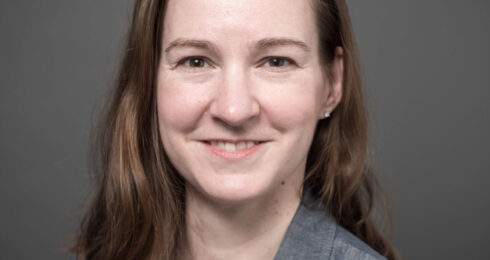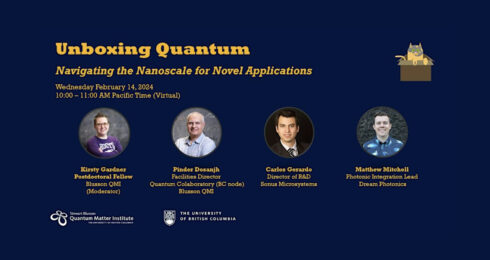Blog: How to survive your first March Meeting
,
The American Physical Society (APS) March Meeting is a special experience in the life of any condensed matter physicist. This year’s event in Boston (March 4 to 8) welcomed more than 12,000 delegates from all over the world including SBQMI graduate student Stepan Fomichev. At this size, the crowds alone can be enough to scare anyone away from physics — but Stepan offers some compelling reasons why they should attend.
,
The conference’s size makes March Meeting different from other academic gatherings: at 70 sessions running in parallel at any given moment throughout the week, you might feel overwhelmed and disconnected from other attendees. And yet when you hear professors and senior students describe it, they almost always emphasize exactly the opposite: March Meeting is all about bringing people together, about catching up with your old collaborators, classmates or students, despite the boundaries (national, natural or otherwise) that might separate your home institutions.
,
At the March Meeting, expect to satisfy your curiosity about nearly any field of condensed matter, and hear presentations on topics that aren’t obviously related. Whether it’s a banker arguing that we should stop comparing financial markets to Brownian motion, a student using statistical mechanics to study traffic jams, or an exotic mixed-order phase transition manifesting in social networks, there is no shortage of new ideas and concepts to take in.
,
But not all talks are created equal. Anyone can submit an abstract if they are an APS member. This creates an opportunity for some fine entertainment, physicist-style, as conference delegates can include investigators of various stripes, from the “Avoid Earth Extinction Society” to the “Internet Science Education Foundation” to retirees who have joined the conference to announce that “if north and south poles exist, there might also be east and west poles,” or that they unified electromagnetism and general relativity (at last!), or to suggest that quantum mechanics merely approximates “non-statistical nonlinear non-unitary post-quantum mechanics.”
,
Plenty of real science can be worth a chuckle too. Sitting through a talk on phase transitions in Kagome lattice antiferromagnetic materials barlowite (discovered by William Barlow) and Claringbullite (first identified by Claringbull), my good friend Kyle Wamer leaned over to announce, “I have finally grasped my true purpose in life. Not academia, not industry, not teaching. No, let’s go find us some fomichevwamerite ©.”
,
Evenings might seem like an opportunity to take a break from the endless shop talk around physics — but you’d be mistaken. Nearly every evening of the four and a half-day conference is filled with receptions, dinners, symposium-related events and even a rock-n-roll sing-a-long. And if you do manage a jailbreak, be prepared to walk into a nearby restaurant to face the familiar glow of orange lanyards and physics-speak from every corner.
,
Giving Your First Talk
, Of course if you have the good fortune to present your very first talk at the March Meeting, you’ll be stressing about your presentation even as you enjoy conference events. You’ll also probably visit the Speaker Ready room to play with the “big black box of time,” a presentation time-keeper with green, yellow and red buttons designed to let you know how badly you’ve run over schedule. Even with the technical rehearsal, there is no guarantee that something won’t go wrong, in which case all that can save your presentation is a fellow colleagues’ laptop and flash drive.
,
However, once the session chair introduces you and sets the timer, none of this matters. From that point on, about 12 minutes of your life will be spent entirely on autopilot. You will only regain your senses once you’re back in your chair, with your friends patting you on the back as you desperately try to remember how it all went.
,
Hearing Giants Speak
, While the March Meeting tends to focus on materials and condensed matter physics, topics will often bump up against more fundamental physics issues. This year I had the pleasure of attending a Foundations of Physics debate to hear such luminaries as Sean Carroll, Carlo Rovelli, and Seth Lloyd vigorously discuss their preferred interpretations of quantum mechanics and whether one can experimentally draw a distinction between them. It was a remarkable event that succeeded against all odds, with Sean Carroll’s face looming large over the proceedings via Skype. Many physicists happily sat on the floor to hear their gurus speak.
,
It was a remarkable event that succeeded against all odds, with Sean Carroll’s face looming large over the proceedings via Skype.
,
,

,
,
,
March Meeting is a unique experience with many sides, academic and otherwise. It’s a wonderful opportunity to keep abreast of developments in your field. Instead of spending hours deciphering a paper, you can question the author right then and there. Besides being a great way to stay in touch with old friends or strike up acquaintances with future collaborators, it also offers an excellent opportunity to practice your presentation skills in a slightly intimidating yet generous and curious environment. In my opinion, any physicist should visit March Meeting at least once.
,
Author: Stepan Fomichev with Sophia Han
, Contact: communications@qmi.ubc.ca
,


